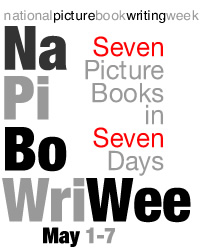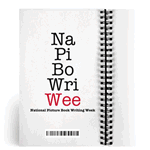NaPiBoWriWee 2011 Day Six – Good Morning!
DAY SIX PEOPLE! We are at DAY SIX! Don’t give up! Keep writing! The end is in sight! And don’t forget, we have a fun random prize giveaway drawing contest on May 8th! Stay tuned for details on that!
Special Announcement: Because we are on Day 6, I’ve posted TWO Guest Author Blogs. The first was Carolyn Crimi, which was posted at 5 AM (PST) for the East Coast folks waking up at 9 AM (EST)! The next one is at noon (PST) – featuring writer/illustrator Don Tate.
For those of you who are still “in the zone” and are gearing up to write Picture Book No. 6, here’s your daily Good Morning blog on writing craft issues. You’ll remember that we have discussed First Drafts, Plot Structure, Theme, The Hero’s Journey, and yesterday, Point of View.
Today’s writing craft issue? GENRE. Even though I am aware that we are writing picture books, I thought I’d share with you some thoughts from my favorite book that I use to teach with… The Writer’s Guide to Crafting Stories for Children by Nancy Lamb (Writers Digest Books ’01). Lamb does a great job of showing the differences between picture books, middle grade novels, etc.
(Keep reading after the jump to find out more about craft…)
Why am I talking about GENRE? I’m bringing this up because I have a sneaking feeling some of you may have written a picture book that veered on the LONG side, and that it might not be a picture book. You might find later that you wrote a first CHAPTER to a chapter book, middle grade or YA novel. And there’s nothing wrong with that. In fact, that’s super cool!
But for those of you struggling with an unwieldly idea that seems too epic and too big for a picture book, I thought you too would benefit from a refresher course in genre. Maybe these definitions below from Lamb’s book will help you figure out how to simplify your novel idea into a more appropriate picture book idea.
From The Writer’s Guide to Crafting Stories for Children by Nancy Lamb (Writers Digest Books ’01):
p. 78-81: “Different Strokes for Different-Aged Folks” “In children’s fiction, the endings of books vary with the age of the reader. Some readers require certainty; others don’t. It all depends on the kind of book, the subject matter and the age of the reader.”
1) Traditional Picture Books: “With little children, the way stories are resolved is critical. The endings of the more serious stories offer comfort and closure to fragile psyches. Little children need to feel safe, to feel protected from the vagaries of a capricious world. Time enough for them to learn about unpredictability and its messy aftermath… In lighter picture books, humor plays a major role. There’s often a twist to the tale, a gentle tweaking of the world in which the characters cavort. Never underestimate a small child’s ability to “get the joke.” Presented properly, humor evokes a giggle and creates a quiet sense of satisfaction in the reader or listener.”
2) Easy Readers and Chapter Books: “Again, these stories end on a comforting note. There are no developments left dangling. All’s well that ends well. The readers of these books are still fragile, still searching for the signposts in life that allow them to negotiate their way through the increasing challenges of a confusing world. They, too, need to know that things turn out all right. At this age level, most stories deal with subjects kids can relate to in their daily lives. In their search for security in a larger world, children this age count on the fact that a satisfying ending awaits them.”
3) Picture Books for Older Kids: “In the olden days, picture books were geared towards little kids. That’s not true anymore. Today some picture books are written for kids up to eight and nine years old and deal with difficult subjects and serious themes… Obviously picture books for older children are more complicated. They aren’t required to have a happy ending. But as Janet Zarem, the distinguished children’s book consultant, says, ‘If you can’t leave them happy, leave them hopeful.’”
4) Middle-Grade Fiction: “When writing for nine to twelve-year-olds the endings don’t have to be happy, but they do have to be satisfying in some fundamental way. In younger books, stories deal primarily with situations and feelings the child might encounter. Here, stories grow out of the characters, their internal changes, and their ability to understand and cope with the world around them. As a consequence, the endings to these books are more complex. For instance, sometimes life doesn’t turn out the way the hero wants it to. Yet she does get some of what she needs – an understanding of how the world works, perhaps, or a new-found ability to cope with a confusing and challenging event. She might have to accept adverse circumstances or even mourn a deep loss. But in all of these situations the hero learns something. She changes, grows and begins to get a firmer grasp on the complexity of the world around her.”
5) Young Adult Books: “By their teen years, kids have developed a high tolerance for ambivalence. They may rail against the fact that their world isn’t painted in black and white. But by now they’ve absorbed the message that things don’t always turn out the way they want them to, that conflicts are often beyond their control and life isn’t always fair. Personal challenge and internal change are hallmarks of books at this age. So is a somewhat dark vision of the world… Death, loss, and existential angst color the endings of many YA books in shades of grey. ‘Sadder but wiser’ is the phrase that springs to mind. Given the angst teenagers experience when their hormones are ranging and their lives are chaotic, it’s no surprise that the endings of their books are often ambivalent. What is a surprise is that young adults embrace this irony and ambiguity so readily.”
######
Our NaPiBoWriWee Day Six schedule:
5:00 AM (PST): Guest Author Blog – extra one posted – Meet Carolyn Crimi, guest author!
9:00 AM (PST): Good Morning Blog posted. I hope you enjoyed reading it. I look forward to your comments!
12 PM (PST): Guest Author Blog will be posted. Today’s guest? Picture book author/illustrator DON TATE! So stop by to hang out with the super cool Don!
10:00 PM (PST): Bedtime Blog will be posted. Stay tuned and please post your progress report in the Bedtime Blog comments section. I look forward to hearing about your Day 6 adventures!
Okay, that’s it from me. Until the next blog posting… Happy Writing! WRITE LIKE YOU MEAN IT! 🙂


Oh. I thought there was some mistake. Like you’d mistakenly scheduled the guest post at the wrong time. LOL
Sorry. I’ll go back to it.
I have a picture book for older kids, Paula, but was told to trash it, because older kids just wouldn’t read it. So this advice was wrong? I hope so, because I really love it.
Thanks for all these wonderful posts, Paula. I love your NaPiBoWriWee challenge. I wrote two more drafts today and am finished with all 7! But I had so many ideas begging for attention, I jotted down notes and think I’ll attack number 8 tomorrow. I can’t wait to start revising my new picture books on Monday!